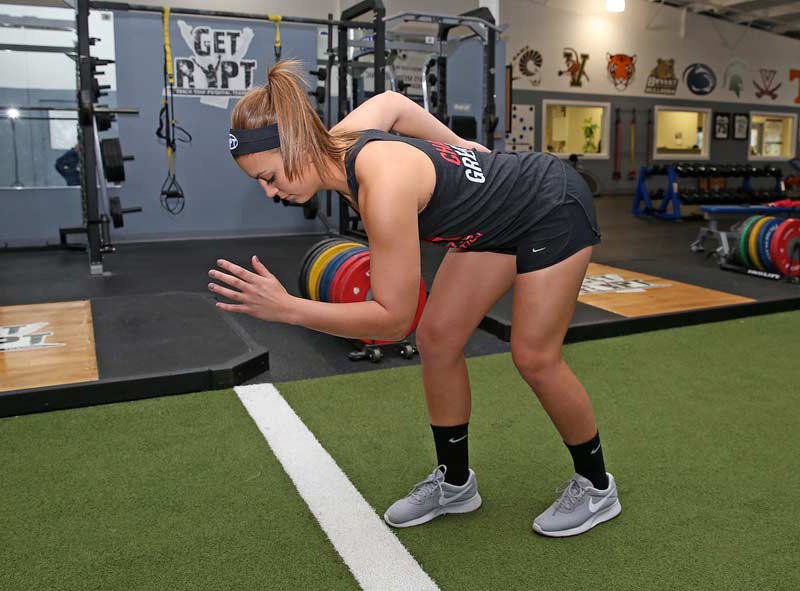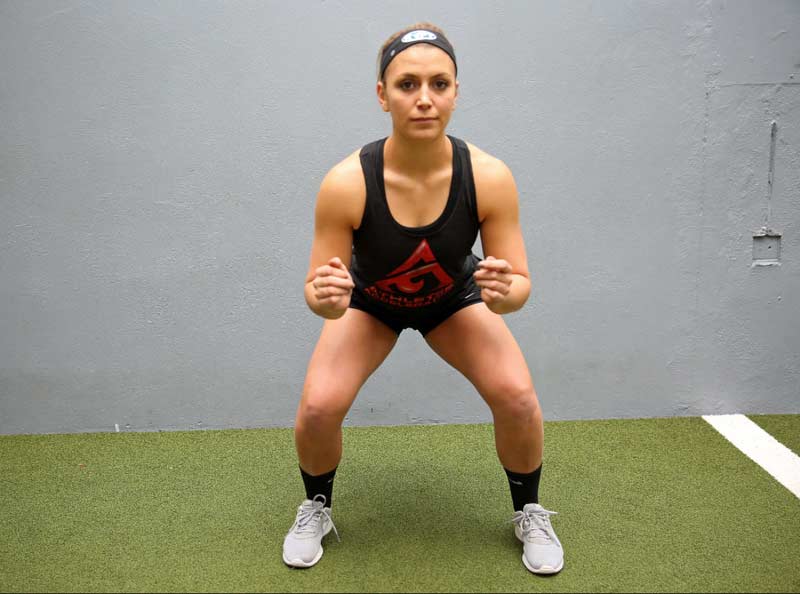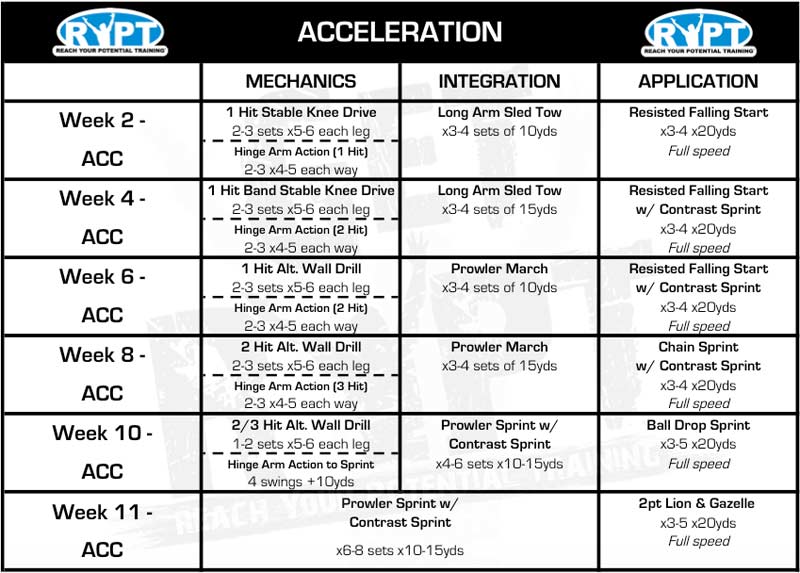[mashshare]

“How did you feel physically during games and practices?” I asked. “Fast?”
I was catching up with one of the athletes I trained after returning home from a stretch at the US Olympic Training Center (OTC) in Chula Vista, CA, where I had the privilege to learn from some of the greatest coaches in modern track and field: Dan Pfaff and Ty Sevin. These coaches invested all their time, knowledge, and expertise to develop their athletes’ abilities to express physical qualities and skills at the highest level. After their tutelage, during my first summer home in New Jersey, I took all of our athletes through training drills and progressions very similar to those I’d done at the OTC. These athletes got fast.
“Oh yeah!” she said. “I’m by far the fastest girl on the team.”
At this point I was, as the kids say, “feeling myself.”
This athlete was playing on the juggernaut Maryland University Women’s Lacrosse team, and clearly the summer training we’d done had paid off.
Through the training process, I was enamored with the impact that linear running mechanics had on performance. Throughout my personal athletic development, there was never much emphasis placed on how I was running. At the OTC I learned a variety of complex drills, ranging from the ever-popular B-skips to more complex concepts like “pawing the ground.” Thanks in part to practicing these drills, I’d seen my own abilities soar to new heights and ran faster than ever.
“Except,” she continued, “I can’t stop.”
“Can’t stop?” I said to myself.
My mind immediately rushed with flashes of how a lacrosse match looks: sharp cuts, changes of direction, sudden accelerations, and controlled decelerations.
I realized I’d missed the boat on a tremendously important concept: court and field sport athletes should not train as track athletes. In fact, training them this way may not only hinder their athletic development, but also raise their risk of injury.
Lesson learned.
Movement Training for the Court and Field Sport Athlete
Since Coach Bobby learned that hard lesson, we’ve invested countless hours researching and implementing the best practices in speed and agility development for court and field sport athletes. Our objective in this article is to share our system for developing linear speed with these athletes.
This article displays our systematic approach and explains the major factors we consider when designing and administering this approach. We outline the overarching concepts that apply to our entire movement training system, and we lay out our method to systematically address deceleration, max velocity, and acceleration, leading up to our final “test week.” We hope to provide actionable strategies that you can immediately take and implement with your own athletes.
Scientific Foundations
Establishing the scientific principles that underlie our coaching is an essential first step in sharing how we apply these concepts—these concepts set the foundation for how we improve linear speed.
So, what are the key trainable variables that apply to improving deceleration, max velocity, and acceleration?
1. Force Production
Admittedly we’re not big math guys, but this model of understanding force is relatively easy to understand and has been very valuable: F=M*A
That’s right. The classic formula of Force = Mass x Acceleration.
Fortunately, we could assume that throughout a movement, the mass will remain constant. This leaves two factors to account for—acceleration and force. Let’s start with acceleration.
Acceleration is the change in velocity or direction per unit of time (m/s). In physics, acceleration includes both increasing and decreasing velocities. For the sake of this article, we’ll consider acceleration as any increase in velocity and deceleration as any decrease in velocity.
Force is any interaction between objects that, if unopposed, will change the motion of an object. A key point to keep in mind is that force is a vector quantity, meaning it accounts for magnitude and direction.

If you want to move forward, push the ground backward. If you want to go to your left, push the ground to your right. In the above picture, Coach Bobby sets an athlete into position with her torso and shin in the angles necessary to propel herself forward. The goal is to channel her ability to produce force and use it to propel her in her desired direction.

We want to teach our athletes how to increase the amount of force they put into the ground and improve the direction in which they apply this force.
Impulse Production
Impulse = Force x Time
This equation primarily represents the number of seconds spent applying force into the ground. It doesn’t only matter how much force an athlete puts into the ground, but also how quickly that force is transmitted.
To teach this concept, we instruct our athletes to punch the ground upon contact. A common fault we see with running fast is that athletes spend too much time on the ground, or as we like to say, they “get stuck in the mud.” More time on the ground drains the amount of force that could be used to propel them in their desired direction.
The biggest takeaway from this variable is this: the quicker you can apply your force, the better.
Video 1. Good ground punching increases the amount of force an athlete has to propel themselves into the direction they want to go. Poor punching decreases the amount of force.
This information about force and impulse applies to each of the subcategories of the next section.
Practical Applications
Practical applications have three subcategories—deceleration, max velocity, and acceleration. While performing each of these, we want our athletes to have the ability to:
- Produce high levels of force
- Produce force in the right direction
- Produce force quickly
1. Deceleration
“It doesn’t matter how fast a sports car can go if it has no brakes” is an analogy quoted countless times. However, we question coaches’ efficacy in developing the ability to decelerate efficiently. So, before you take the sexy information from this article that explains how to get your athletes faster, make sure that you are first teaching them how to slow down. Before we can produce force, we must make sure we can properly reduce force.
Decelerating is a skill. The body positions, neuromuscular timing, and soft tissue qualities necessary to absorb and redirect forces that come with decelerating from high velocities take time to develop. Taking the time to teach the skill of deceleration reduces the risk of injury and increases athletic performance.
Teaching deceleration skills reduce injuries and increase athletic performance. Share on XAthletes are more at risk for injuries during the eccentric phase of muscle action—landing from a jump, changing directions, or coming to a complete stop. And it’s our responsibility as physical preparation coaches to teach our athletes better movement strategies for absorbing and transferring forces.
In addition to reducing the risk of injury, improved deceleration skills help maximize sports performance. If two athletes have equal ability to accelerate and run at max velocity, and one athlete can decelerate and change directions more efficiently, that athlete has a distinct advantage. We see this in the “shifty” running back who does not having blazing speed but manages to make defenders miss him consistently with the ability to redirect his path.
We build deceleration into all of our movement training sessions by dedicating a deceleration zone. Athletes must break down—or come to a complete stop—in an athletic position (pictured below). The distance from the end of the drill to the deceleration zone depends on the velocity of the drill, athlete training age, and phase of training. At Reach Your Potential Training (RYPT), we use different cone colors to represent where deceleration zones begin and end.

2. Max Velocity
Max velocity running is one of the most demanding tasks a human can perform per unit of time. From time-motion analysis studies, we’ve seen that the overwhelming majority of sport actions occur at sub-maximal speeds. If this is the case, why should we train max velocity?
We help our athletes develop the ability to run at max velocity to:
- Reduce fatigue and quicken recovery from sub-max efforts
- Prepare soft tissues and joint structures for forces they may encounter during practice and competition
- Prepare the nervous system for the demands of max velocity
- Take advantage of the vertical body position associated with max velocity that transfers to the more horizontal body position associated with acceleration—this is the reason we teach max velocity before we teach acceleration.
We start our movement training sessions by exposing athletes to environments and tasks that are relatively ordered and less complex. Then we progress to more chaotic and complex environments and tasks. We categorize our movement training sessions into three sections—mechanics, integration, and application.
Mechanics. During mechanics, we teach the positions we want our athletes to be in. The velocities of movement are slow relative to the integration and application phases. We emphasize what the athletes should be feeling.
Integration. During integration, we build on the skills we just covered in mechanics. The movements here are relatively faster. The challenge for our athletes is to maintain the body positions addressed during mechanics in a more dynamic environment.
Application. Application is where we tie it all together. This is full-speed. Go time. Time to compete. Application presents the most complex, high-speed tasks to our athletes. This is the most challenging, most competitive, and most fun section of movement training. If we only did mechanics and integration, they would revert to their old inefficient strategies of moving once they hit high velocities. Application is essential because it creates an environment where coaches can provide immediate feedback on how athletes are applying strategies from mechanics and integration.

3. Acceleration
Court and field sports, unlike track and field, are characterized by many accelerations over the course of a competition. These accelerations are initiated from a broad variety of positions, velocities, and directions. Regardless of where or how accelerations are initiated, the desired outcome is the same: get from point A to point B in the appropriate amount of time.
The ability to repeat max-effort accelerations determines game outcomes. Share on XWhile many sub-maximal accelerations occur throughout a practice or competition, it’s often the ability to repeat max-effort accelerations that determines game outcomes. These max-effort accelerations include a wide receiver blowing past a cornerback on a deep fade, two soccer players rushing toward the sideline to battle for a loose ball, and a basketball player exploding into a passing lane for a steal and breakaway lay-up.
When teaching acceleration, we use the analogy that it’s best to take off like an airplane, not like a helicopter. When a plane takes off, it stays patient and gradually gains elevation as it increases its speed. Helicopters, however, pop right up off the ground and go vertically into the sky.
An athlete who pops up into a vertical position too soon limits their potential to reach high velocities. Many times failure to hold an acceleration position is due to an athlete’s general weakness. Increasing their relative and absolute strength aids their ability to hold these acceleration positions longer.
Anti-extension core work improves a player's ability to keep a stable, rigid core during gait. Share on XWe aim to help the athletes get stronger through their upper body, lower body, and core. Specifically, we want them to become more competent at anti-extension core exercises. This improves their ability to keep a stable and rigid core during gait.
Maintaining a consistent body angle through acceleration limits the degree of energy leaks. Increasing general strength and training acceleration technique improve an athlete’s ability to maintain body positions. And maintaining these body positions allows them to stay in the acceleration phase longer.

Final Thoughts
Three major commonalities link all sports. Athletes will produce force rapidly, reach high velocities, and decelerate from these velocities.
Each of these embodies a separate skill and requires time and effort to develop. Ignoring any one of these leaves your athletes at a higher risk of injury and reduces the likelihood they will reach peak performance. To maximize the development of these skills:
- Teach your athletes how to decelerate
- Reinforce proper body positions
- Emphasize producing high levels of force quickly
References
Boden, B. P., Torg, J. S., Knowles, S. B., & Hewett, T. E. (2009). Video analysis of anterior cruciate ligament injury: abnormalities in hip and ankle kinematics. The American Journal of Sports Medicine, 37(2), 252–259.
Duthie, G., Pyne, D., & Hooper, S. (2003). Applied physiology and game analysis of rugby union. Sports Medicine (Auckland, N.Z.), 33(13), 973–991.
McInnes, S. E., Carlson, J. S., Jones, C. J., & McKenna, M. J. (1995). The physiological load imposed on basketball players during competition. Journal of Sports Sciences, 13(5), 387–397.
Since you’re here…
…we have a small favor to ask. More people are reading SimpliFaster than ever, and each week we bring you compelling content from coaches, sport scientists, and physiotherapists who are devoted to building better athletes. Please take a moment to share the articles on social media, engage the authors with questions and comments below, and link to articles when appropriate if you have a blog or participate on forums of related topics. — SF
[mashshare]
 Jamie Pasquin is an Assistant Strength and Conditioning Coach at Dartmouth College, where he works primarily with Men’s Basketball, Women’s Soccer, Women’s Lacrosse, Skiing, and Sailing, and assists with Football. Prior to Dartmouth College, Jamie was an Assistant Strength and Conditioning Coach at Quinnipiac University and a Graduate Assistant Strength and Conditioning Coach at Sacred Heart University. Currently pursuing his Master’s degree in Exercise Science and Nutrition from Sacred Heart University, he received his Bachelor’s degree in Applied Exercise Science from Springfield College. While at Springfield, Jamie was a member of the Pride’s football team.
Jamie Pasquin is an Assistant Strength and Conditioning Coach at Dartmouth College, where he works primarily with Men’s Basketball, Women’s Soccer, Women’s Lacrosse, Skiing, and Sailing, and assists with Football. Prior to Dartmouth College, Jamie was an Assistant Strength and Conditioning Coach at Quinnipiac University and a Graduate Assistant Strength and Conditioning Coach at Sacred Heart University. Currently pursuing his Master’s degree in Exercise Science and Nutrition from Sacred Heart University, he received his Bachelor’s degree in Applied Exercise Science from Springfield College. While at Springfield, Jamie was a member of the Pride’s football team.




